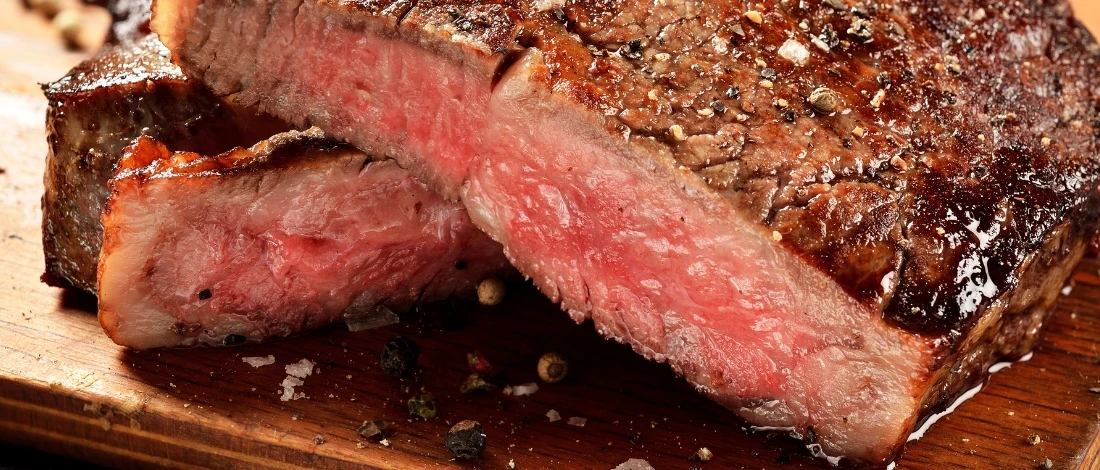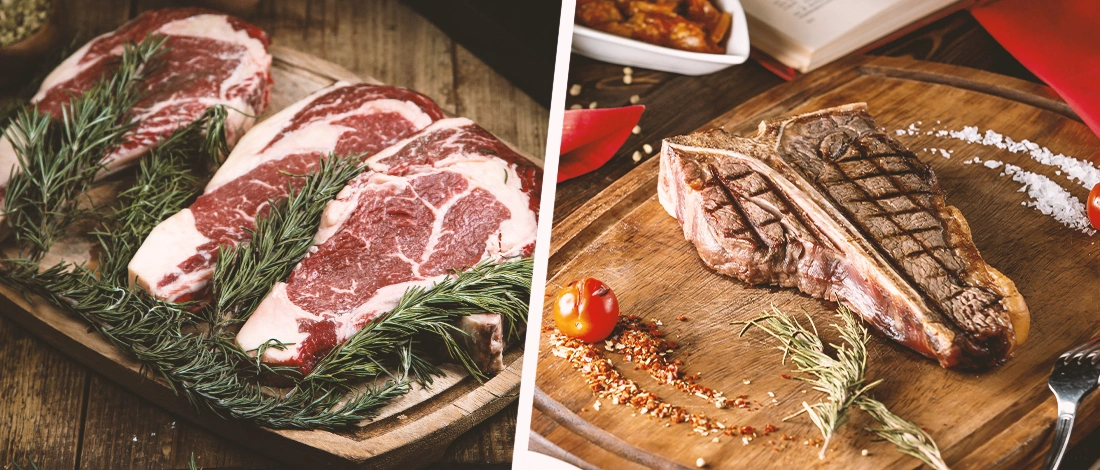Every steak lover will tell you that it is a bit challenging to choose between filet mignon and ribeye steaks. Flavor, tenderness, or fat content, both cuts have something to offer.
Can you tell the difference between these two cuts?
Do not worry; we have done the work for you. You will find all the differences between these cuts below, including the correct cooking methods for a delicious steak.
Quick Summary
- Filet Mignon and Ribeye are both premium cuts of meat, with the former being from the tenderloin muscle and the latter from the beef rib section.
- While Filet Mignon is tender and less fatty, Ribeye is juicier and more flavorful due to its high fat content.
- A 2022 study published in the National Library of Medicine explored the physicochemical changes in fillet steak subjected to various cooking methods, revealing that pan-frying with oil led to greater moisture loss and increased lipid content, while air frying preserved moisture better [1].
- The choice between the two depends on personal preference, with Filet Mignon being ideal for those preferring a leaner cut and Ribeye for those who enjoy a meaty, juicy steak.
Filet Mignon Vs. Ribeye - an Overview
Filet mignon and ribeye are both expensive, popular, and incredibly mouth-watering. They are excellent options for meat lovers. Therefore, you can be spoilt for choice.
Although they offer a rich flavor and texture, they come from different parts of the cow, which means they vary in fat and muscle. In addition, they have other notable differences.
About Filet Mignon Steak
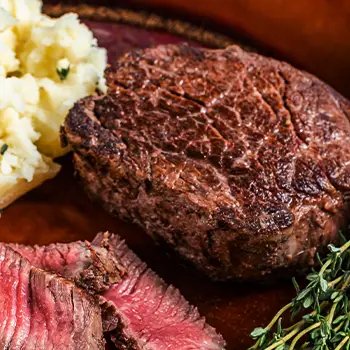
Filet mignon is a premium cut from the middle of the tenderloin muscle, which is part of the loin primal. The tenderloin is found in the short loin.
This highly-demanded beef cut makes about 2-3% of the average cow, and that’s why it’s rare and expensive.
It’s not just a premium steak - it’s made to impress. Many steak lovers crown it as the king of all beef cuts due to its buttery texture.
Filet mignon is the tenderest steak in a cow due to its location [2].
It lies in a non-weight-bearing muscle known as psoas major, found inside the rib cage next to the backbone.
Therefore, this muscle is not used, and the connective tissue does not grow tough through continuous exercise. As a result, filet mignons are incredibly tender.
However, due to less marbling, it lacks a juicier flavor. This makes it a perfect choice for sauces, bacon wrap, seasonings, marination, and smoking to give it a more pronounced taste and added flavor.
And if you are limiting fat consumption, filet mignon is a better choice. It has a high protein content and about 2.3 grams of saturated fat - very low compared to other steaks.
About Ribeye Steak

Ribeye steak is cut from the primal section known as the beef rib between the shoulder and loin. It is the same part where prime rib roast is sourced [3].
This section has more intramuscular fat, creating white streaks of fat. This high-fat content creates bold juiciness in ribeye steaks.
The ribeye steak is very popular among steak lovers and grill masters - it’s the epitome of immense juiciness and intense buttery flavor.
The flavor of ribeye filet speaks for itself.
This steak cut can either be bone-in or boneless. The piece of rib bone adds moisture and flavor to the meat.
We have seen that some people prefer juiciness to tenderness. But, again, it’s all about preferences when it comes to steaks.
Due to its rich marbling, ribeye cut has become a preferred and expensive choice.
In addition, it comes in different parts - the eye of the ribeye (longissimus), the complexus, and the rib crown (spinalis).
The longissimus dorsi muscles, the main muscles in the ribeye steak, do not get much exercise in the rib cage area; therefore, they are tender but not as soft as filet mignons.
Strip steak may be a substitute for recipes requiring filet mignon and rib eye steak.
Also Read: Sirloin vs Filet
6 Differences Between Filet Mignon and Ribeye
If you are yet to pick your best, the following differences will help make up your mind.
1. Beef Cut Source
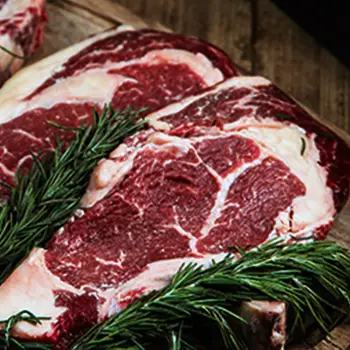
As mentioned earlier, the main difference between filet mignon and ribeye is part of the animal they are cut from.
When it comes to sourcing your meat, both cuts are readily available in grocery stores, online meat deliveries, supermarkets, and at your local butcher.
Always go for a prime-grade steak. Despite their expensive nature, they give incredible results when cooked.
Wagyu ribeye steak is one of the premium perfect steak options, a culmination of all steaks. This marbled meat is close to culinary perfection.
2. Appearance and Size

Ribeye steak is bigger compared to the small round cuts of filet mignon. As a result, a filet mignon is almost half of a typical ribeye steak.
When it comes to appearance, ribeye steak’s marbling is thick and defined - white lines of fat all over ribeye steak.
On the other hand, filet mignon has low-fat content with thin streaks of fat and finer-grained muscle.
3. Texture
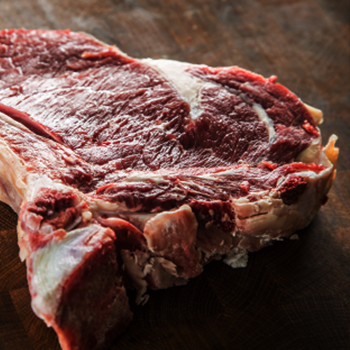
These steaks come from two different muscles giving them distinct textures. But, typically, both ribeye and filet mignon are soft.
As seen earlier, filet mignon is a steak from the tenderloin, a muscle that is hardly exercised and has fewer connective tissues. Therefore, it is very soft meat. It’s buttery and melts instantly in your mouth.
On the flip side, the ribeye steak is a little tougher than the filet mignon.
This is because the muscles in the rib section are used more than the tenderloin. As such, cooking filet mignon steak is easier--even easier than strip steak.
But, ribeye steak is considered more tender compared to other cuts and has a more juicy flavor due to its high fat content.
Also Read: Most Tender Cut of Steak
4. Flavor
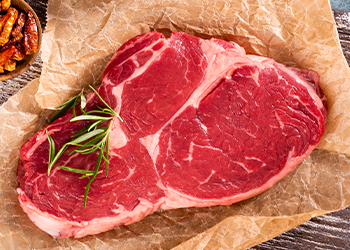
If you are a flavor-kinda steak enthusiast, ribeye is your guy. It is full of juiciness and rich flavors, and the incredible fat marbling makes it a delicious and tender cut.
On the other hand, the filet mignon lacks the juicy, savory taste due to its low-fat content.
Due to its mild flavor, it is a great match for sauce, toppings, and it goes well with grilled sweet potatoes and light broccoli salad.
5. Cost
Filet mignon is a pricey steak. But, with its fork-tender texture and scarcity, filet mignon is worth the extra price, especially for special occasions.
On the other hand, ribeye is not cheap, but it is more affordable than the filet mignon.
6. Cooking Method
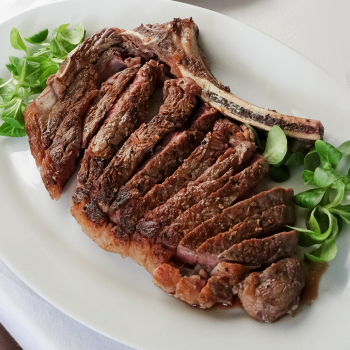
Another noticeable difference is the cooking method of ribeye-filet mignon cuts.
The filet mignon cuts should be prepared as rare to medium-rare, as low temperatures are ideal for maintaining their tenderness.
However, filet mignon cooks much faster and is prone to dryness when overcooked due to less marbling. Due to the low-fat content, you should be careful while cooking this steak.
Filet mignon can be cooked using various methods such as pan-frying, roasting, grilling, and broiling.
A small amount of olive oil, salt, and pepper on a pan is all you need to get a good sear.
Read More: Filet Mignon With Herb Butter Recipe
Contrarily, the ribeye steak is best cooked quickly over higher temperatures since it has a high-fat content for a great sear. Therefore, it should be cooked medium-rare for the best results.
You can cook ribeye on the reverse sear, pan roast, or on a grill. You do not need seasoning while cooking ribeye since its fat content makes it juicy.
A small amount of salt and pepper is perfect for bringing out the steak flavor. When combined with some cabernet sauvignon, it is perfect.
“A steak needs fat to taste great.”
- Tom Colicchio-Celebrity Chef & Owner of Crafted Hospitality
As large cuts, ribeyes should be finished off on a medium to low grill for utmost tenderness. Besides, they are prone to charring while cooking. Therefore, a pair of tongs is essential to avoid flare-ups.
Other meat comparisons:
References:
- https://www.ncbi.nlm.nih.gov/pmc/articles/PMC8744971/
- https://www.omahasteaks.com/blog/what-is-filet-mignon/
- https://www.thespruceeats.com/rib-eye-steak-overview-and-tips-336255
- https://pubmed.ncbi.nlm.nih.gov/33158683/


